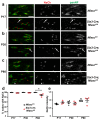The paranodal cytoskeleton clusters Na+ channels at nodes of Ranvier
- PMID: 28134616
- PMCID: PMC5279941
- DOI: 10.7554/eLife.21392
The paranodal cytoskeleton clusters Na+ channels at nodes of Ranvier
Abstract
A high density of Na+ channels at nodes of Ranvier is necessary for rapid and efficient action potential propagation in myelinated axons. Na+ channel clustering is thought to depend on two axonal cell adhesion molecules that mediate interactions between the axon and myelinating glia at the nodal gap (i.e., NF186) and the paranodal junction (i.e., Caspr). Here we show that while Na+ channels cluster at nodes in the absence of NF186, they fail to do so in double conditional knockout mice lacking both NF186 and the paranodal cell adhesion molecule Caspr, demonstrating that a paranodal junction-dependent mechanism can cluster Na+ channels at nodes. Furthermore, we show that paranode-dependent clustering of nodal Na+ channels requires axonal βII spectrin which is concentrated at paranodes. Our results reveal that the paranodal junction-dependent mechanism of Na+channel clustering is mediated by the spectrin-based paranodal axonal cytoskeleton.
Keywords: axon; ion channel; mouse; myelin; neuroscience.
Conflict of interest statement
The authors declare that no competing interests exist.
Figures









Similar articles
-
Accumulation of Neurofascin at Nodes of Ranvier Is Regulated by a Paranodal Switch.J Neurosci. 2020 Jul 22;40(30):5709-5723. doi: 10.1523/JNEUROSCI.0830-19.2020. Epub 2020 Jun 17. J Neurosci. 2020. PMID: 32554548 Free PMC article.
-
Super-resolution of nodal and paranodal disruption in anti-pan-neurofascin-associated autoimmune nodopathy.Front Immunol. 2025 Feb 20;16:1540859. doi: 10.3389/fimmu.2025.1540859. eCollection 2025. Front Immunol. 2025. PMID: 40051618 Free PMC article.
-
Glial βII Spectrin Contributes to Paranode Formation and Maintenance.J Neurosci. 2018 Jul 4;38(27):6063-6075. doi: 10.1523/JNEUROSCI.3647-17.2018. Epub 2018 May 31. J Neurosci. 2018. PMID: 29853631 Free PMC article.
-
Submembranous cytoskeletons stabilize nodes of Ranvier.Exp Neurol. 2016 Sep;283(Pt B):446-51. doi: 10.1016/j.expneurol.2015.11.012. Epub 2016 Jan 14. Exp Neurol. 2016. PMID: 26775177 Review.
-
Molecular specializations at nodes and paranodes in peripheral nerve.Microsc Res Tech. 1996 Aug 1;34(5):452-61. doi: 10.1002/(SICI)1097-0029(19960801)34:5<452::AID-JEMT5>3.0.CO;2-O. Microsc Res Tech. 1996. PMID: 8837021 Review.
Cited by
-
Axonal Membranes and Their Domains: Assembly and Function of the Axon Initial Segment and Node of Ranvier.Front Cell Neurosci. 2017 May 9;11:136. doi: 10.3389/fncel.2017.00136. eCollection 2017. Front Cell Neurosci. 2017. PMID: 28536506 Free PMC article. Review.
-
TDP-43 maximizes nerve conduction velocity by repressing a cryptic exon for paranodal junction assembly in Schwann cells.Elife. 2021 Mar 10;10:e64456. doi: 10.7554/eLife.64456. Elife. 2021. PMID: 33689679 Free PMC article.
-
β spectrin-dependent and domain specific mechanisms for Na+ channel clustering.Elife. 2020 May 19;9:e56629. doi: 10.7554/eLife.56629. Elife. 2020. PMID: 32425157 Free PMC article.
-
Nodal β spectrins are required to maintain Na+ channel clustering and axon integrity.Elife. 2020 Feb 13;9:e52378. doi: 10.7554/eLife.52378. Elife. 2020. PMID: 32052742 Free PMC article.
-
Age-dependent regulation of axoglial interactions and behavior by oligodendrocyte AnkyrinG.bioRxiv [Preprint]. 2024 Apr 2:2024.04.01.587609. doi: 10.1101/2024.04.01.587609. bioRxiv. 2024. Update in: Nat Commun. 2024 Dec 30;15(1):10865. doi: 10.1038/s41467-024-55209-7. PMID: 38617359 Free PMC article. Updated. Preprint.
References
-
- Amor V, Feinberg K, Eshed-Eisenbach Y, Vainshtein A, Frechter S, Grumet M, Rosenbluth J, Peles E. Long-term maintenance of Na+ channels at nodes of Ranvier depends on glial contact mediated by gliomedin and NrCAM. Journal of Neuroscience. 2014;34:5089–5098. doi: 10.1523/JNEUROSCI.4752-13.2014. - DOI - PMC - PubMed
-
- Bekku Y, Vargová L, Goto Y, Vorísek I, Dmytrenko L, Narasaki M, Ohtsuka A, Fässler R, Ninomiya Y, Syková E, Oohashi T. Bral1: its role in diffusion barrier formation and conduction velocity in the CNS. Journal of Neuroscience. 2010;30:3113–3123. doi: 10.1523/JNEUROSCI.5598-09.2010. - DOI - PMC - PubMed
-
- Bhat MA, Rios JC, Lu Y, Garcia-Fresco GP, Ching W, St Martin M, Li J, Einheber S, Chesler M, Rosenbluth J, Salzer JL, Bellen HJ. Axon-glia interactions and the domain organization of myelinated axons requires neurexin IV/Caspr/Paranodin. Neuron. 2001;30:369–383. doi: 10.1016/S0896-6273(01)00294-X. - DOI - PubMed
Publication types
MeSH terms
Substances
Grants and funding
LinkOut - more resources
Full Text Sources
Other Literature Sources
Molecular Biology Databases
Miscellaneous

